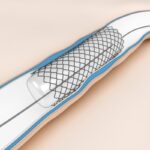Original title: Relation of C-reactive protein levels to instability of untreated vulnerable coronary plaques (from the PROSPECT study). Reference: Kelly CR et al. Am J Cardiol. 2014;Epub ahead of print. The original PROSPECT study included 697 patients with acute coronary syndrome (ACS) undergoing culprit artery percutaneous coronary intervention (PCI) followed by intravascular ultrasound (IVUS) to the rest of...
Dedicated two everolimus eluting stent strategies improve bifurcation PCI outcomes
Original title: Dedicated two-stents technique in complex bifurcation percutaneous coronary intervention with use of everolimus-eluting stents: The EES-bifurction study. Reference: Nisharamed I. Kherada, et al. International Journal of Cardiology 2014;174:13-17 Bifurcation PCI, especially 1.1.1 Medina bifurcation lesions PCI, is particularly challenging and has been associated with increased restenosis. The use of drug eluting stents (DES) associated to...
Increased security with bivalirudin than with heparin alone in patients without ST segment.
Original title: Heparin monotherapy or bivalirudin during percutaneous coronary intervention in patients with non-ST-segment elevation acute coronary syndromes or stable ischemic heart disease: results from the Evaluation of Drug-Eluting Stents and Ischemic Events registry. Reference: Bangalore S et al. CircCardiovascInterv. 2014;Epub ahead of print. Bivalirudin compared to unfractionated heparin as monotherapy is associated with a lower risk of...
The length of the stent is not an event predictor with the new generation of DES. It is the end of the Spot stenting?
Original title: Impact of the Stent Length on Long-Term Clinical Outcomes Following Newer-Generation Drug-Eluting Stent Implantation. Reference: Ik Jun Choi et al. Am J Cardiol 2014;113:457-464. Completely cover the lesion with a sufficiently long stent has been the preferred strategy that emerged from drug-eluting stents (DES). However, for the first-generation DES stent length has been a predictor of...
Currently a patient receiving angioplasty is more likely to die from non-cardiac causes
Original title: Trends in cause of death after percutaneous coronary intervention. Reference: Spoon DB et al. Circulation. 2014; Epub ahead of print. This retrospective study evaluated the specific cause of death in 19077patients who received angioplasty in a center between 1991 and 2008. To perform the analysis, the track was divided into three time periods: 1991-1996, 1997-2002,...
3rd generation zotarolimus-eluting stent non- inferior to everolimus
Original title: Third-generation zotarolimus-eluting and everolimus-eluting stents in all-comer patients requiring a percutaneous coronary intervention (DUTCH PEERS): a randomized, single-blind, multicentre, non-inferiority trial. Reference: Von Birgelen C et al. The Lancet. 2014; Epub ahead of print. In the 3rd generation zotarolimus-eluting stent, platform was modified to increase flexibility and make implant easier in complex lesions. This study was...
Almost 40 % of those who initially receive clopidogrel then switch to prasugrel or ticagrelor in clinical practice.
Original title: In-hospital switching of oral P2Y12 inhibitor treatment in patients with acute coronary syndrome undergoing percutaneous coronary intervention: Prevalence, predictors and short-term outcome. Reference: Dimitrios Alexopoulos et al. Am Heart J 2014;167:68-76.e2. Given the availability of 3 Oral P2Y12 receptor inhibitors (clopidogrel, prasugrel, and ticagrelor) with different safety and efficacy profiles, the change from one to another...
Unprotected trunk in diabetics: angioplasty with good long-term results but more revascularization
Original title: Coronary artery bypass graft versus percutaneous coronary intervention with drug-eluting stent implantation for diabetic patients with unprotected left main coronary artery disease: D-DELTA registry. Reference: Meliga Emanuele, et al. EuroIntervention 2013; 9:803-808 Diabetes increases cardiovascular risk events because of their involvement in diffuse form of the vessels, thereby generating more events and changes in revascularization strategy...
Everolimus -eluting stent to 3 years, most security was the key difference.
Original title: Everolimus-eluting stents in patients undergoing percutaneous coronary Intervention: Final 3-year results of the Clinical Evaluation of the XIENCE V Everolimus Eluting Coronary Stent System in the Treatment of Subjects With de Novo Native Coronary Artery Lesions trial. Reference: Sorin J. Brener et al. Am Heart J 2013;0:1-8. The XIENCE stent (Abbott Vascular, Santa Clara, CA) is...
Primary angioplasty with 2nd generation drug-eluting stents
Original title: Stent thrombosis with second-generation drug-eluting stents compared with bare-metal stents: Network meta-analysis of primary percutaneous coronary intervention trials in ST-segment–elevation myocardial infarction. Reference: Circ Cardiovasc Interv. 2013; Epub ahead of print. To compare the safety and efficacy of 2nd generation drug-eluting stents (DES) versus bare metal stents (BMS) in the context of primary angioplasty was conducted...









